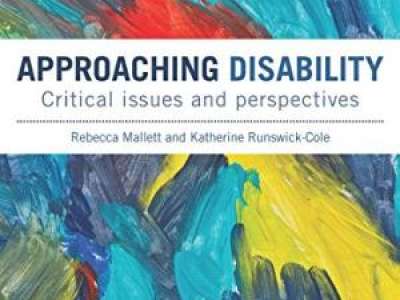
Approaching Disability: Critical Issues and perspectives. London, Routledge, Taylor & Francis Group
In a lift, I was asked that question…”I hope you don’t mind me asking, but what’s wrong with you?” I replied, “Nothing”’
(Author’s personal encounter, p125)
As the recipient of a PMG bursary I was given the option of writing a book review. I selected this book as it focuses on an area that I am interested in but have never yet explored more deeply – the social model of disability and the disabled rights movement. In this review all quotes and page numbers are from the text.
The book is an introduction to various approaches to understanding disability starting with the Social Model of Disability. [the terms disabled people/children are consistent with the model and the authors' own usage - Ed].
It describes how this model was developed in the UK in the 1980s in reaction to the United Nations International Year of Disabled Persons (p90); the work of charities which were seen to be paternalistic in nature; and the pursuit of an agenda that ignored and side-lined disabled people. Its publication resulted in groups of disabled people campaigning for rights and equality, and this radicalism established the basic theories and terminology for disability studies. Through their experience the Social Model was formulated to explore the distinction between impairment – the functional effects of the medical condition – and disability - ‘difficulties caused for disabled people by disabling environments, barriers, attitudes and cultures’ (p10). This helped provide a practical and theoretical base for study, and give voice to their concerns.
After this outline we are told about alternatives to the Social Model, including feminist and multi-cultural perspectives, the latter presented in the form of a ‘world tour’. These hold a central tenet – that disability is a social construct – but the authors add further depth by questioning its Eurocentric bias (the tendency to interpret disability in terms of European values and experiences) and introducing greater breadth to the study of disabilities, such as the need to include the effects of religion in the way disabled people are treated in India for example, or the concept of Ubuntu (loosely translated as ‘interrelatedness’) from southern Africa (p33). We are presented with further criticisms of the Social Model’s theoretical base, for example, that it fails to take into account the experience of all groups of disabled people (e.g. disabled children, people with learning disabilities) or of the impact (‘intersectionality’ p99) of multiple discriminations on the basis of race, class and gender. From the authors’ viewpoint, these critiques are to be embraced to help increase the inclusiveness of disability studies, and free them from the bias of ‘white, middle class, professional, physically disabled men’ (p98).
Using extremely diverse subjects, the authors demonstrate how disability is something that is socially created, rather than a necessary concomitant of having an impairment. We are offered the results of studies of the historical experience and cultural representations of disabled people. We are also introduced to the tools to analyse the treatment of disabled people in film, television and other media, using various approaches and methodologies, such as quantitative content analysis and transgressive resignification, which seek ways of ‘reclaiming potentially harmful and hurtful depictions’ (p61).
Each of the studies gives further evidence to support the authors’ central argument that it is the way in which society seeks to define disabled people that creates the disability. They cite many illuminating – and chilling – instances of how this social act serves to disempower and oppress disabled people. Some of the more powerful sections focus on the mass slaughter of disabled people in the Holocaust and individual tragedies, such as the killing of Brent Martin ‘kicked to death for a £5 bet’ (quoted from Quarmby, 2011 on p70).
For the authors, it is crucial to understand that disability is cultural and social in nature in order to explain why events such as these happen. They use further historical studies to support this theory, and they describe how the medically defined ‘patient’ with ‘impairments’ emerges from a time when ‘normality was a hodge podge’ (quoted from Stiker, 1999 on p72). Indeed, many parts of the book show the impact that the ‘medical gaze’ (p81) has on disabled people, and how the development of medicine has acted as a tool that, all-too-often, defines disabled people in terms of their ‘deficits’. They are particularly enlightening when discussing the disabled child and the impact of developmental psychology.
Being a health professional, I found these parts especially interesting, as they offered a different way for me to view and evaluate my practice; to consider how often I try to rely on diagnosis to understand the disabled person’s condition, or to apply various judgemental standards, without questioning their basis. I found the information of great benefit to help me try to differentiate between the times when my ‘readings of disability…stifle or enable’ (p139).
In summary, I would recommend this book as a very readable and clear introduction to the area of disability studies and the politics of disability. As health professionals, I feel it is essential that we constantly question our practice, and seek to understand our biases and opinions. I found much in this book that both prompted me to do this as well as providing valuable facts and tools to assist me in this on-going process.






.jpg)



no comments
Add your comment...